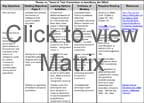Weekly Objectives
In this week you will...
- synthesize historical developments with emerging national and state trends in the identification of gifted students.
- develop an awareness of the existence of special populations of gifted students.
- identify dual-exceptionality gifted students and their unique needs.
- investigate the referral and identification process in your school district.
Historical and Current Trends in Gifted Education
A Declaration of the Educational Rights of the Gifted Child
Written by Barbara Clark
Growing Up Gifted, pg. 19-20
- It is the right of a gifted child to engage in appropriate educational experiences even when other children of that grade level or age are unable to profit from the experience.
- It is the right of a gifted child to be grouped and to interact with other gifted children for some part of their learning experience so that the child may be understood, engaged, and challenged.
- It is the right of a gifted child to be taught rather than to be used as a tutor or teaching assistant for a significant part of the school day.
- It is the right of a gifted child to be presented with new, advanced, and challenging ideas and concepts regardless of the materials and resources that have been designated for the age group or grade level in which the child was placed.
- It is the right of a gifted child to be taught concepts that the child does not yet know instead of relearning old concepts that the child has already shown evidence of mastering.
- It is the right of a gifted child to learn faster than age peers and to have that pace of learning respected and provided for.
- It is the right of a gifted child to think in alternative ways, produce diverse products, and to bring intuition and innovation to the learning experience.
- It is the right of a gifted child to be idealistic and sensitive to fairness, justice, accuracy, and the global problems facing humankind and to have a forum for expressing these concerns.
- It is the right of a gifted child to question generalizations, offer alternative solutions, and value complex and profound levels of thought.
- It is the right of a gifted child to be intense, persistent, and goal-directed in the pursuit of knowledge.
- It is the right of a gifted child to express a sense of humor that is unusual, playful, and often complex.
- It is the right of a gifted child to hold high expectations for self and others and to be sensitive to inconsistency between ideals and behavior, with the need to have help in seeing the value of human differences.
- It is the right of a gifted child to be a high achiever in some areas of the curriculum and not in others, making thoughtful, knowledgeable academic placement a necessity.
- It is the right of a gifted child to have a low tolerance for the lag between vision and actualization, between personal standards and developed skill, and between physical maturity and athletic ability.
- It is the right of a gifted child to pursue interests that are beyond the ability of age peers, are outside the grade level curriculum, or involve areas as yet unexplored or unknown.

